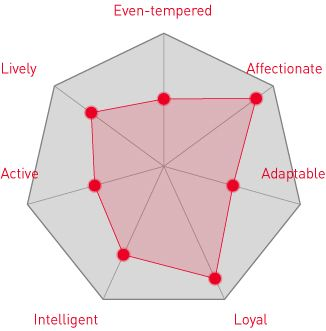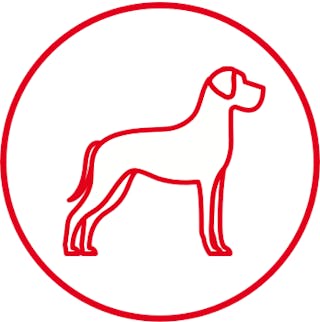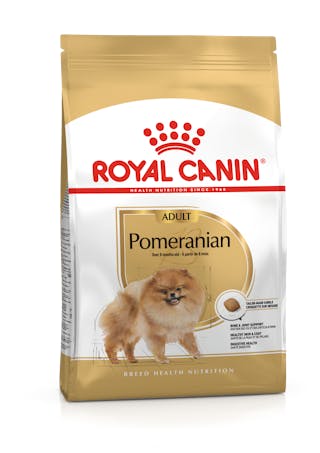
Let's talk Pomeranians
Descended originally from sled dogs – albeit much smaller in size today – Pomeranians are smart, playful and full of energy. Known for their foxy faces, ‘smiley’ features and luscious coats – not to mention that distinctive mane-like ‘ruff’ –
their bushy tail completes the picture. Always tuned in to approaching strangers, they also make great watch dogs. Big-dog attitude in a small-dog body, really.
Official name: Pomeranian
Other names: Zwergspitz, Toy Spitz, Pom
Origins: Germany

| Drooling tendencies |
|
Warm weather? |  |
| Grooming needs |  |
Cold weather? |  |
| Shedding level |  |
Suited to apartment living |  |
| Barking tendencies | High |
Can stay alone?* |  |
| Energy level (high, low, medium)* | Low | Family pet?* |  |
| Compatibility with other pets |  |
* We advise against leaving pets alone for long stretches. Companionship can prevent emotional distress and destructive behaviour. Speak to your veterinarian for recommendations.
Every pet is different, even within a breed; this snapshot of this breed specifics should be taken as an indication.
For a happy healthy and well-behaved pet, we recommend educating and socializing your pet as well as covering their basic welfare needs (and their social and behavioral needs.
Pets should never be left unsupervised with a child.
Contact your breeder or veterinarian for further advice.
All domestic pets are sociable and prefer company.However, they can be taught to cope with solitude from an early age. Seek the advice of your veterinarian or trainer to help you do this.


| Baby age | Birth to 2 months |
| Puppy age | 2 to 10 months |
| Adult age | 10 months to 8 years |
| Mature age | 8 to 12 years |
| Senior age | 12 to 22 years |

1/7
Get to know the Pomeranian
All you need to know about the breed
Packing a punch way above their size, Pomeranians may be a whole lot smaller than their sled-pulling ancestors, but they still retain that same mentality. Bold, brash and fearless, they also have an insatiable curiosity for everything around them. They therefore make excellent watchdogs.
On the flipside, Pomeranians can be a bit of a barky breed. So, if you like peace and quiet, or have sensitive neighbours, they may not be the one for you.
That aside, there is so much to love about the Pomeranian personality. Intelligent and attentive, they are always up for interaction with their owners, so are a lot of fun to have around. Also, with a maximum height of just 12 inches, the Pomeranian doesn’t need tons of exercise and will adapt well to most home set-ups.
The smallest member of the German Spitz family of dogs, which includes the Samoyed, Alaskan Malamute, and Norwegian Elkhound, the Pomeranian is known in some countries as the ‘Toy Spitz’. The breed that we know today was developed in Germany, probably in the 1700’s, but was gradually bred to be smaller.
Before long, the Pomeranian had become very in-demand with a host of distinguished fans. Perhaps most notably, Queen Victoria was a huge devotee of the breed and helped to cement their popularity (see more on this part of the Pomeranian’s story in our History of the Breed section).
With a cheeky charm about them, the Pomeranian certainly has a lovely temperament and are a real pleasure to have as a pet. Also, if you’re wondering how long Pomeranians live for, they have an unusually long lifespan, often going strong well into their teens.
No wonder then that the Pomeranian is one of the most popular of the toy breeds. They are also a regular in lists of the top 20 favourite dogs in the world.

2/7
2 facts about Pomeranians
1. Stone Age origins
Descended from the German Spitz, the Pomeranian’s lineage goes all the way back to the Stone Age. Excavations in northern Germany unearthed well-preserved specimens that are believed to be the breed’s most ancient ancestors.
2. Back to Titanic
In 1912, two Pomeranians were among only three dogs to survive the sinking of the Titanic. The two lucky animals, along with their owners, were among the survivors fortunate to find themselves on a lifeboat. In the film of the same name, Rose is pictured at the end of the movie holding a Pomeranian.
1. Stone Age origins
Descended from the German Spitz, the Pomeranian’s lineage goes all the way back to the Stone Age. Excavations in northern Germany unearthed well-preserved specimens that are believed to be the breed’s most ancient ancestors.
1. Stone Age origins
Descended from the German Spitz, the Pomeranian’s lineage goes all the way back to the Stone Age. Excavations in northern Germany unearthed well-preserved specimens that are believed to be the breed’s most ancient ancestors.
History of the breed
To go back to their origins, the Nordic ancestors of the Pomeranian were sled dogs in the Arctic. These hardy animals were commonly known as the Wolfspitz or Spitz, and the Pomeranian is descended from the German Spitz.
Named after the historical region of Pomerania (in northern Poland and Germany) where they originated, the Pomeranian breed we know today is thought to have been developed in the 1700’s. Originally a much larger dog, the size was reduced through selective breeding and many different coat colours were also introduced.
Within a short space of time, the Pomeranian began gaining popularity – and, before long, they were even in demand with royalty. The first royal we know to have had a Pomeranian was Queen Charlotte – Queen-consort of King George III of Great Britain. Her two Pomeranians were depicted in paintings by Sir Thomas Gainsborough.
Later, Queen Victoria became a huge fan of the Pomeranian too – to the point that she even set up her own breeding kennel. Her influence meant they also had the largest number of entries at Crufts, the U.K. dog show, for some years.
The inaugural breed club was established in 1891 – at the first ever Crufts event – and the breed standard formulated shortly afterwards. By 1898, the breed had been registered in the US, to the American Kennel Club, and was formally recognised there in 1900. Needless to say, the Pomeranian has been a popular fixture at dog shows – and in the modern home – ever since.

4/7
From head to tail
Physical characteristics of Pomeranians
1. Face
Closely resembling a fox, the face is small and inquisitive with bright dark-brown eyes.
2. Body
Body is short and compact with a level topline.
3. Tail
Heavily plumed, bushy tail is usually curled over the back.
4. Coat
Dense double coat has short, thick fur underneath and a longer topcoat.
5. Fur
Colouring can range from brown, white, orange and grey, among others.

5/7
Things to look out for
From specific breed traits to a general health overview, here are some interesting facts about your Pomeranian
Favour a harness instead of a leash
Like other small-breed dogs, Pomeranians can be susceptible to a progressive condition called ‘tracheal collapse’ – which combines the degeneration of the tracheal cartilage with a weakening of the tracheal membrane leading to a potential narrowing of the airways. Although the condition is inherited, it can be exacerbated by a collar and leash – especially if your Pomeranian lunges forward or the owner pulls back too hard. Symptoms can include a honking noise, coughing, wheezing or trouble breathing, and, in serious cases, they may also faint. For that reason, it’s always best to opt for a harness-style lead. If the condition is severe, surgery can be an option.

6/7
Caring for your Pomeranian
Grooming, training and exercise tips
Being so tiny, Pomeranians have lower exercise needs than average. However, they still require a daily walk, and ideally two, with the chance to stretch their little legs and sniff around outdoors. Because of the Pomeranian’s small size, dog parks are best avoided as they may inadvertently get knocked over by larger breeds – and they themselves will sometimes challenge bigger animals. When at home in the garden or backyard, it’s important to keep a close eye on them as these miniature Houdinis are also known for escaping – even through small gaps. Pomeranians can be prone to middle-age spread, so keep them active, though they like nothing better than snuggling up in your lap.
That glorious fox-like coat is one of the Pomeranian’s defining features, but you’ll need to give it regular attention to ensure it stays at its best. A light daily brushing will help remove any dead hair and keep it looking shiny. And, as Pomeranians have a double coat – a soft, thick undercoat of dense hair and a longer outer coat – they will benefit from a deeper brushing once a week. A full professional grooming for your Pomeranian, including a bath, is recommended every four to six weeks. As the Pomeranian can shed quite profusely, these regular sessions should help to keep excess hair away from the carpet too. Nails should be kept short, teeth brushed at least weekly (and daily ideally) and ears checked regularly.
As a very smart breed of dog, the Pomeranian will thrive on a tailored training programme that provides both mental and physical stimulation. They will enjoy sharing games with you at home, too. For those that show an aptitude to progress further, they can also do well in disciplines such as agility, obedience and rally – and they make good therapy dogs too. Just a couple of things to bear in mind… The Pomeranian can have a tendency to be a bit ‘vocal’, especially as they are rather suspicious of strangers. Early socialisation can help with this. They can also take a little longer than average when it comes to toilet training, so kindness, consistency and all-round general patience are key.
7/7
All about Pomeranians
No, the Pomeranian is descended from the German Spitz, and although they have many similar characteristics, they are two different breeds. The main difference is the size. By way of comparison, the Pomeranian is usually around half the size of the German Spitz.
Always on high alert, Pomeranians are very sensitive to what’s going on around them and like to tell everyone else about it too. They also tend to be a bit suspicious of strangers and can be quite vocal about that as well. Early socialisation, puppy training and using positive reinforcement to teach them the “Quiet” command can all help.
Read More about Breeds


How to adopt a dog

Things to consider before getting a dog
Sources
1 - Veterinary Centers of America https://vcahospitals.com/
2 - Royal Canin Dog Encyclopaedia. Ed 2010 and 2020
3 - Banfield Pet Hospital https://www.banfield.com/
4 - Royal Canin BHN Product Book
5 - American Kennel Club https://www.akc.org/






